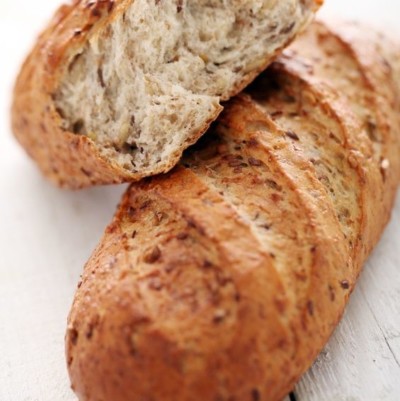
Bȃtard
What is a Bȃtard?
A bȃtard is a loaf of French bread 6 to 12 inches long and 3 to 6 inches wide.1 Bȃtards are similar in taste and appearance to baguettes but are half the length and slightly wider.
Also known as a torpedo loaf, bȃtards consist of flour, yeast, salt, and water. They are traditionally made using wheat flour but have been adapted to other grains such as:
- Whole Wheat
- Rye
- Sprouted Grains
Bȃtards have golden brown crusty exterior with white-colored and open crumb interior. The outer surface has score marks that give it a characteristic appearance and allow controlled expansion of the loaf during oven spring baking.1
Origin
The origin of bȃrads are debated and cannot be traced to one region or bakery. They are an adaptation of the French baguette and are smaller in length and thicker in width than a traditional baguette.1 Bȃtards have no standard list of ingredients and many variations of formula and shaping techniques exist.
How are bȃtards made?
Bȃtards are made using a straight dough method followed by proofing, scoring, and baking.3 Straight dough bulk fermentation involves the following steps:
- Mixing: All ingredients are mixed at low speed for 20-30 minutes at 21-27oC (69.8- 80.6°F) to form a homogeneous dough3
- Resting: Dough is left to ferment for 100 minutes2
- Punching: Dough is punched down and then allowed to ferment for 55 minutes2
- Dividing and shaping: Dough is divided and formed into an elongated shape by folding edges into the center. The ends are rolled and tapered while the center is left wider than a traditional baguette.
- Final proof
- Scoring
- Baking
- Cooling
- Packaging
Formula
Bȃtards may be made from any yeast-based bread recipe. Ingredients can include whole wheat flour, sourdough starter, sprouted wheat or whole grains.
A basic bȃtard formula is as follows:4
- 5-1/3 cups (24 oz / 680 g) unbleached bread flour
- 2 teaspoons (0.5 oz / 14 g) salt, or 1 tablespoon coarse kosher salt
- 2-1/4 teaspoons (0.25 oz / 7 g) instant yeast
- 2 cups (16 oz / 454 g) lukewarm water (about 95°F or 35°C)
Shaping a bȃtard
Shaping begins after bulk fermentation there are many methods used to create the bȃtard shape. Here is a commonly used shaping technique:5
- Divide dough into small portions
- Using the hands loosely and not overworking the dough, flatten the dough into a rectangle shape
- Fold the bottom third of the dough to the center and press firmly
- Gently push the heel of your hand into the dough expelling any air pockets, making a tight seam
- Fold the top third down to the center and press firmly to make a tight seam
- Fold the whole loaf in half and press firmly along the edge to seal the seam
- Lightly roll back and forth to elongate the ends of the loaf
- Place the loaf in a well-floured couche, seam side down for rising
References
- Collar, C. “Bread: Types of Bread.” Encyclopedia of Food and Health, 2016, pp. 500–507., doi:10.1016/b978-0-12-384947-2.00085-4.
- Delcour, J A., and R. Carl. Hoseney. Principles of Cereal Science and Technology. AACC International, 2010. Page 156
- “Production Methods.” Federation of Bakers, www.fob.uk.com/about-the-bread-industry/how-bread-is-made/production-methods/.
- Reinhart, P. “Recipe: Classic French Bread.” NPR, NPR, 24 Nov. 2009, www.npr.org/templates/story/story.php?storyId=120580907.
- “Batard Bread: Everything You Need To Know.” Make Bread At Home, Make Bread At Home, 16 Nov. 2017, makebreadathome.com/batard-bread-everything-you-need-to-know/.

